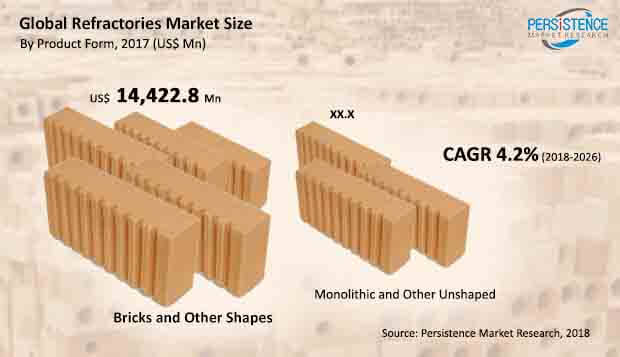Refractories Market Segmented By Monolithic, Bricks Forms with Bauxite, Alumina, Kaolin, Magnesia, Graphite, Zircon Material in Steel, Cement, Nonferrous Metals, Glass
Industry: Chemicals and Materials
Published Date: June-2018
Format: PPT*, PDF, EXCEL
Delivery Timelines: Contact Sales
Number of Pages: 238
Report ID: PMRREP3510
The global sale of refractories was pegged at 30,674.3 KT in 2017. In terms of volume, the global refractories market is projected to reach 43,676.9 KT by the end of 2026, expanding at a volume CAGR of 4.1% over the forecast period (2018–2026). In terms of value, the global refractories market is expected to reach to US$ 41,102.9 Mn by 2026 end, exhibiting a CAGR of 4.2% over the forecast period.
India is expected to exhibit promising growth in the global refractories market, registering a CAGR of 5.4% over the forecast period. Driven by sales growth of refractories across various applications, the India market is expected to witness a sustainable growth rate over the coming years.
Refractories applications have been witnessing considerable demand in Asian countries, such as China, Japan, India, Korea and ASEAN. The demand is fueled by rising capital investments in setting up of large-scale projects in the infrastructure, steel, mining (impacting metallurgy sector) and cement sectors and subsequent development of distribution & sales network of refractories in the region. Besides, large scale investments in other industries such as glass is also expected to drive the demand for refractories through 2026.
Refractories have been finding significant applications in the manufacturing processes for steel, iron, nonferrous metals, glass, cement and other industries.
China and Europe are important regions in terms of the relevant end-use industries at a global level and these regional markets are expected to grow further in the near future, which in turn is expected to create significant opportunities for growth of the regional refractories market over the forecast period.
However, high dependency of refractory manufacturers across the globe on raw material imports from China is expected to pose a challenge to growth of the global refractories market.

On the basis of product form, the refractories market is segmented into monolithic & other unshaped, and the bricks & other shapes segments. Both the segments are projected to account for an almost equal share of the global refractories market through 2026.
The growth of the monolithic & other unshaped segment is estimated to remain relatively higher though, over the forecast period, and is expected to account for approximately 50.2% of the total market share in terms of volume by 2026. Expanding at a healthy growth rate, the monolithic & other unshaped segment is expected to create significant growth opportunities over the coming years.
Among the refractory mineral used, the bauxite segment is expected to consistently represent a dominant share over the forecast period. By value, it is expected to reach a market value of about US$ 30,031.7 Mn by the end of 2026. The demand for alumina refractory mineral type is also expected to remain high across different regions. The magnesia segment is estimated to exhibit a significant growth rate throughout the forecast period.
Steel: Expanding at a CAGR of 4.6% over the forecast period, the segment is expected to create an incremental $ opportunity of US$ 9,064.8 Mn by 2026 end.
Cement: This segment is expected to reach a market value of US$ 4,045.4 Mn by 2026 end, expanding at a CAGR of 3.1%.
Glass: This segment is expected to grow at a CAGR of 5.1% between 2018 and 2026.
The report highlights some of the key companies operating in the global refractories market such as Vesuvius plc, RHI Magnesita, Krosaki Harima Corporation, Chosun Refractories ENG Co., Ltd., Calderys Refractories Limited, Compagnie de Saint-Gobain S.A., and Refratechnik Holding GmbH, among others.
The key market players are focusing on strengthening their sales & distribution network in the refractories market. Some of the market players are also focusing on inorganic growth strategies such as strategic acquisitions supported by organic growth strategies such as manufacturing capacity expansions across regions to augment volume sales globally & cater to the local demand as well.
| Attribute | Details |
|---|---|
|
By Product Form |
|
|
By Refractory Mineral |
|
|
By End Use Industry |
|
|
By Region |
|
To know more about delivery timeline for this report Contact Sales
